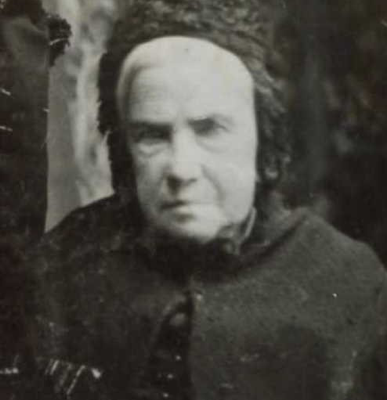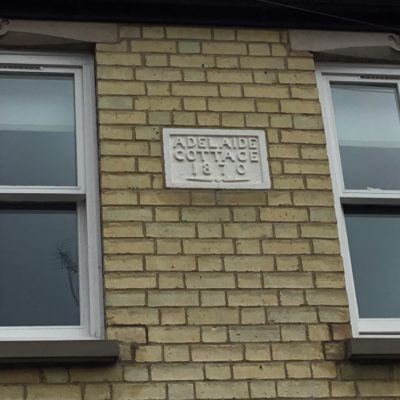Search by topic
- archaeology
- Building of Local Interest
- charity
- church
- crime
- dressmaker
- fire
- Great Eastern Railway
- Listed building
- Mapping Relief
- medieval
- oral history
- poverty
- Public House
- Rattee & Kett
- Religious House
- Roman
- scholar
- school
- Then and Now
- tudor
- women
- work
- world war one
- world war two
Search by text
50 Ainsworth Street
50 Ainsworth Street
Number 50 is one of a terrace of six houses, called Orleans Terrace, on the east side of Ainsworth Street, built in 1877.
1881 census
Charles F Hines, head, 45, railway inspector, b. Bealings, Suffolk
Eliza Hines, wife, 45, b. Bealings, Suffolk
Helena H Hines, daughter, 15, mantle maker, b. Cambridge
Ada R Hines, daughter, 13, dress & mantle maker, b. Cambridge
Blanch J Hines, daughter, 10, scholar, b. Cambridge
Charles A Hines, son, 7, scholar, b. Cambridge
1891 census
John Bagstaff, head, widower, 60, boot & shoe maker, b. Norwich
Ellen Bagstaff, daughter, 36, plain sewer of shirts, b. Norwich
Charles Bagstaff, grandson, 12, scholar, b. Cambridge
Sarah Cobbold, lodger, 83, lives on means, b. Burwell, Cambridgeshire
John Bagstaff’s wife Lydia died in Norwich in 1871. The family then moved to Cambridge and were living in Cross Street in 1881.
John’s daughter Ellen and grandson Charles were living with him in 1891. It is possible that Charles was Ellen’s son as the 1911 census says that she had two children.
John Bagstaff died in October 1891.
1901 census
Ellen Bagstaff, head, single, 46, dressmaker, b. Norwich, Norfolk
Bob Bagstaff, son, 2, b. Cambridge
William Anderson, boarder, 34, corporation servant, b. Cambridge
Tom G B Taylor, boarder, 33, tallyman, b. Plymstead, Essex
Boarder Tom Taylor was a tallyman. The Victorian Occupations website states that a Tallyman is ‘someone who sold goods that were paid for in instalments’.
Ellen had moved to 12 Ainsworth Street by 1911.
1911 census
Frederick George Darler, head, 24, baker, b. Cambridge
Ethel May Darler, wife, 27
Reginald George Darler, son, 8 months
Married 3 years, 1 child
Ethel May Darler (née Gentle) and her son Reginald were both born in Cambridge.
1921 census
Frederick George Darler, head, 35, baker & confectioner, b. Cambridge
Ethel May Darler, wife, 38, home duties, b. Cambridge
Reginald George Darler, son, 10, b. Cambridge
Owen Stanley Darler, son, 4, b. Cambridge
Frederick Darler had his own shop, F G Darler, Baker, Grocer & Confectioner, at 20 Occupation Road.
1939 register
Edward Townley, b. 2 May 1897, kitchen porter (heavy work), ARP Air Warden
Daisy N Townley, b. 28 Aug 1899, housewife
2 children (closed records)
In the interwar period, Addenbrooke’s Hospital collected silver paper from the public, to raise funds but also to promote civic mobilisation. In The Politics of Hospital Provision in Early Twentieth-Century Britain, Brian M Doyle stated that ‘Mass collection campaigns were also instituted, especially for eggs and silver paper, bringing in a wide range of volunteers, mobilizing supporters … and facilitating support from women and children.’ He continues ‘Equally important in terms of civic mobilisation, although of considerably less value financially, was the collection of silver paper which took off in the mid-1920s. This activity was well-suited to mass involvement – it was ubiquitous, cost nothing and lent itself to communal efforts.’
Donors were listed weekly in the the local newspaper (Cambridge Daily News, 31 May 1939):
Silver Paper – Tony and Margaret Townley, 50 Ainsworth Street
Tony and Margaret Townley must be the two children in the 1939 register.
Edward and Daisy Townley were still living at no. 50 in 1972 when they reached their golden wedding anniversary (Cambridge Daily News, 27 December 1972):
Golden Boxing Day Party – a letter from the Prime Minister Mr. Edward Heath, is among the many congratulations that Mr. and Mrs. Edward Townley, of 50 Ainsworth Street, Cambridge, have received for their golden wedding anniversary.
Edward and Daisy Nellie Townley celebrated with a family party on Boxing Day. Their son, Anthony, and daughter, Margaret, both of whom live in Cambridge, were there.
Mr. and Mrs. Townley first met when Mrs. Townley, now aged 73, was working in a fruit shop opposite the Round Church during the First World War.
Mr. Townley is now aged 73. Before he retired, he worked for 50 years as a university servant. Mrs. Townley did a lot of work for the Conservative party and until 10 years ago, she was a cashier at the Dorothy.
Daisy Townley had a letter published the following month (Cambridge Daily News, 17 January 1973):
FINGS AIN’T WOT THEY USED TO BE!
December 26, 1947 was my silver wedding day. I had a son in the Army and a daughter aged 11. I took her to the Victoria Cinema to hear the wedding service of our Princess and Prince Philip which we both enjoyed very much.We had just heard my daughter had passed for the High School ad on our way home we called into a large shop to look at school uniforms.
We didn’t have enough coupons to get the whole lot and a kindly old gentleman saw the disappointment on my child’s face and offered his own coupons which he didn’t want.
I wonder if the same thing would happen today. Self first, it seems, no time for other folks. I have some good friends who have been grand to me, but they are like myself, elderly and very grateful for what they get.
I think the times have changed for the worse since 1947.
The lack of kindness, politeness,; the greed for money which is not used properly and the couldn’t-care-less feeling.
The motto, England expects everyone to do the duty, just does not exist any more. The less they do the less they want to do – still expect their pay. Let’s build a new Britain with people who love their country.
D.N. TOWNLEY, 50 Ainsworth Street, Cambridge
Source: 1881–1921 Census, England & Wales Marriages 1837–2005, England & Wales Deaths 1837–2007, National Burial Index For England & Wales, Victorian Occupations,
Contribute
Do you have any information about the people or places in this article? If so, then please let us know using the Contact page or by emailing capturingcambridge@
License
This work is licensed under CC BY-NC-SA 4.0








